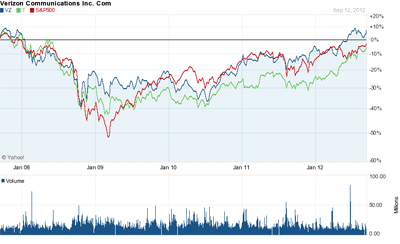The big telecom players used to be some of the most solid and reliable stocks out there...but that's not the case nowadays, and you can't go blindly chasing yields, either, warns Jim Trippon of Dividend Genius.
Telecom giant Verizon (VZ) recently raised its quarterly dividend from 50 cents per share to 51.5 cents, for an annual payout of $2.06. This is a 3% increase in the dividend, and is the sixth consecutive year for a dividend increase.
The current yield on the $2.06 dividend payment will be 4.7%, which equals the yield of its major telecom rival AT&T (T). AT&T increased its dividend last December, yet some investors were disappointed in the small increases by the two.
The dividend hike by Verizon is a small step to continue to keep pace with AT&T, as these two companies often mirror each other in their dividend strategies.
Investors have a long history of favoring telecoms as dividend stocks, going back decades to the sleepier days of investing. While not strictly widow and orphan stocks anymore, as telecom has become a much more volatile industry with all the rapid technological changes, these two stocks remain bellwether dividend stocks.
How much do investors rely on these dividend payments? Last year, Verizon paid out $5.6 billion in dividends, while AT&T paid out more than $10 billion.
Telecom Payouts
Verizon and AT&T are considered conservative dividend stocks, which isn’t a bad thing at all when you look at the yields. With yields pushing 5% in today’s low-interest-rate environment—particularly with stocks of a couple of companies that aren’t likely to disappear anytime soon—you have a pretty decent investment.
Other telecoms are also noted as good dividend payers. Look at regional players, smaller names with sometimes slightly less stable businesses, such as regional telecom CenturyLink (CTL), which yields 6.9%. Windstream (WIN) currently pays a dividend that yields 9.9%, a yield which recently briefly reached more than 10%. Then there’s Frontier Communications (FTR), which yields 8.6%.
So what’s the catch with these stocks? Why wouldn’t investors choose them over the more staid, lower-yielding big two of Verizon and AT&T? Safety of the dividends. Risk.
Risky Business, Risky Dividends
Frontier Communications had a dividend cut followed by a share-price drop, and some analysts are extremely cautious on Windstream. Windstream has invested heavily in capital expenditure and is attempting to integrate some acquisitions, but its near-term income growth prospects are not attractive.
Analysts have forecast negative growth for Windstream. The company also has seen its free cash flow diminish in the last couple of years, from $762 million in the second quarter of 2010 to $604 million in this year’s second quarter. The stock also trades at a relatively high multiple of just under 35, while Frontier’s current P/E is 45.
A Difficult Industry
Telecom is still a capital-intensive industry, and with the rapid changes in technology, such as fiber optics, broadband, and wireless, companies have had to scramble to pay up to get in or stay in the game.
Also, there’s been considerable capital investment previously in now depreciating landlines, a business that’s shifting from a legacy one to a potential albatross, as landlines are an area of diminishing revenues and may one day be simply a vestigial part of the telecom industry.
Modern Metrics
Furthermore, telecom stocks used to have high dividend-payout ratios, but were able to cover their payouts with earnings. No more.
Verizon’s payout ratio is edging close to 200%, while AT&T’s is even higher, at 235%. The regional players sport even more striking payout ratios, with Frontier at 523% and CenturyLink at 354%.
The metric most often used now by the companies to point toward dividend coverage or safety is cash flow, which is fine in context. But as has been pointed out, in addition to high costs in the industry, there is depreciation, which in some industries is more of a technical accounting matter than it may be in telecom. Equipment needs to be replaced.
So free cash flow rather than operating cash flow might give a better indication of margin of safety, or lack of one. Verizon, for example, has roughly $30 billion in operating cash flow, with levered free cash flow at more than $11 billion. But the smaller players have a tighter window on this.
Investors should check carefully into the financial numbers of the telecoms before buying the stocks for dividends. The days of telecoms simply providing an endless stream of reliable cash to investors without much attention focused on the business operations or the industry are, or should be, over. A little extra attention can keep you from making a mistake and help you profit instead.
Subscribe to Dividend Genius here...
Related Reading:
4 Stocks Even a Forensic Accountant Can Love



















